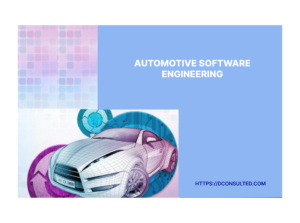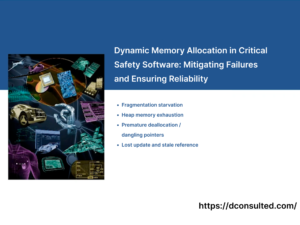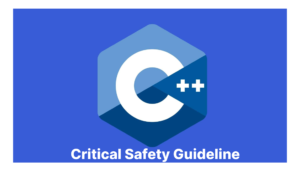
Empowering Your People Isn’t Enough | DConsulted
Learn why empowering employees alone doesn’t guarantee success. Discover how strategic alignment and leadership support drive real results.

In the world of automotive technology, safety remains a paramount concern. Car manufacturers, automotive software service companies, and autonomous driving entities continually seek ways to enhance safety protocols. Two crucial frameworks in this pursuit are ISO 26262 and SOTIF (Safety of the Intended Functionality).

In this article, we delve into the importance of SOTIF, demystify its integration with ISO 26262, and explore the various business benefits for the automotive industry.
Safety of the Intended Functionality (SOTIF) is a critical dimension in ensuring the overall safety of autonomous vehicles. While ISO 26262 primarily addresses functional safety, SOTIF extends the scope to focus on potential hazards arising from system behavior, even when the system functions as intended. This includes scenarios where the system operates correctly but encounters complex environmental interactions, edge cases, or rare events that are not typically covered by functional safety analysis.
In autonomous driving and ADAS, whenever vehicles interact dynamically with unpredictable environments, the significance of SOTIF becomes evident. Understanding and mitigating risks associated with the intended functionality is key to achieving a comprehensive safety framework. SOTIF thus acts as a complementary layer to ISO 26262, filling gaps in conventional safety approaches by addressing hazards related to the normal operation of systems under unforeseen conditions.
Furthermore, SOTIF addresses limitations in the design and interpretation of the intended functionality, providing a clearer contrast to ISO 26262, which focuses on systematic faults and random hardware failures. By integrating SOTIF, automotive safety frameworks can more effectively manage the full spectrum of potential hazards, ensuring a higher level of safety and reliability.
Integrating SOTIF with ISO 26262 involves a comprehensive approach to automotive safety. While ISO 26262 addresses random hardware failures and systematic faults, SOTIF focuses on hazards stemming from a system’s intended functionality, including design inadequacies and environmental interactions. Unlike random failures, which ISO 26262 primarily addresses, SOTIF addresses potential safety issues arising from the system’s normal operation. Systematic failures, also within ISO 26262’s purview, involve predictable errors in design or implementation. SOTIF, or ISO/PAS 21448, targets safety concerns related to a system’s correct functioning under foreseeable conditions, extending beyond hardware failures. It encompasses scenarios where system functionality might inadequately address operational contexts or external factors, leading to unsafe situations not caused by component failures or systemic faults.
To integrate these frameworks effectively, it’s crucial to establish a seamless connection between the identification and treatment of hazards under SOTIF and the systematic functional safety measures under ISO 26262. This involves a comprehensive risk assessment that considers not only malfunctions but also potential hazards arising from the system’s normal operation. Such risk assessments typically include scenario-based testing and validation to identify and mitigate risks associated with complex environmental interactions and edge cases.
Achieving this integration requires a collaborative effort between engineering teams with a clear understanding of both standards. Organizations can create a robust safety framework that seamlessly addresses functional safety and intended functionality by aligning the identification and mitigation processes, utilizing shared tools and methodologies, and fostering interdisciplinary communication.
Listed below are some business benefits of integrating SOTIF with ISO 26262:
By integrating SOTIF with ISO 26262, automotive companies can achieve a more comprehensive safety assurance mechanism. This integration enhances the reliability of safety-critical functions and minimizes the risks associated with unexpected behaviors, such as complex environmental interactions and edge cases, during the intended functionality.
As the automotive industry becomes increasingly regulated, compliance with safety standards is paramount. Integrating SOTIF and ISO 26262 ensures that companies meet evolving regulatory requirements, facilitating market entry, gaining customer trust, and providing a competitive edge in the market.
Reduced Liability and Recall Costs:
Proactively addressing potential hazards through SOTIF integration can significantly reduce the risk of accidents and system failures. This, in turn, lowers liability and recall costs, protecting both the brand reputation and the financial bottom line. Case studies have shown that companies implementing comprehensive safety frameworks see measurable reductions in recall incidents.
A well-integrated safety framework streamlines the development process by identifying and mitigating risks early in the design phase. This proactive approach leads to faster development cycles, allowing companies to stay ahead in the rapidly evolving automotive landscape. Early risk identification and management reduce the need for later-stage fixes and rework, speeding up time-to-market
The intersection of SOTIF and ISO 26262 lies in their shared commitment to automotive safety. While ISO 26262 primarily addresses systematic failures (predictable errors in design or implementation) and random hardware failures (unpredictable component failures), SOTIF complements this by focusing on hazards arising from the intended functionality. This includes scenarios where the system operates correctly but faces complex environmental interactions or rare events not typically covered by functional safety analysis.
The overlap occurs in the comprehensive risk assessment process, where identifying and treating potential hazards are integrated to create a robust safety framework. This synergy ensures a holistic approach, covering both functional safety and the safety of intended functionality, resulting in a unified safety assurance mechanism for the automotive industry
For example, a car manufacturer identifies the need to develop an Autonomous Emergency Braking System (AEBS) that can operate in diverse driving conditions and meet stringent safety standards. The AEBS must detect obstacles with high accuracy and initiate braking to avoid collisions. However, the system faces challenges in recognizing obstacles in adverse weather conditions, leading to potential safety risks.
The manufacturer conducts extensive scenario analysis, including simulations of various weather conditions like heavy rain, fog, and snow, to understand the limitations of the AEBS sensors and algorithms. To address these issues, the manufacturer improves the sensor fusion technology, combining data from cameras, radar, and lidar to enhance obstacle detection. They also refine the AI algorithms responsible for interpreting sensor data.
The improved AEBS undergoes rigorous testing and validation processes, both in virtual environments and real-world testing. The system’s performance is evaluated against the SOTIF standard to ensure it can handle the identified scenarios without system failure.
This example illustrates how the automotive industry applies SOTIF and ISO 26262 standards to enhance the safety of advanced driver-assistance systems (ADAS) like AEBS. By following a structured approach to scenario development, issue identification, analysis, solution development, and testing and validation, manufacturers can mitigate risks and ensure the safety of the intended functionality of their systems.
Implementing the Safety of the Intended Functionality (SOTIF) in the automotive industry comes with challenges, reflecting the evolving nature of autonomous vehicle technology and the need for a robust safety framework.
One primary challenge lies in defining the scope of “intended functionality.” Differentiating between normal operation and unforeseen scenarios can be subjective, leading to ambiguity in hazard identification. Clear guidelines and industry-wide standards are crucial to address this challenge.
Complexity of Unforeseen Scenarios
Autonomous vehicles operate in dynamic environments where unpredictable situations may arise. Identifying and addressing hazards associated with these unforeseen scenarios poses a significant challenge. Developing comprehensive scenarios for testing and validation becomes intricate, requiring advanced simulation and testing methodologies.
Interdisciplinary Collaboration
SOTIF necessitates collaboration between functional safety and other engineering disciplines, such as perception and artificial intelligence. Bridging the gap between these domains can be challenging due to differing methodologies, terminologies, and risk assessment approaches. Effective communication and cross-disciplinary training are essential to overcome this barrier.
Lack of Standardized Assessment Methods
Implementing SOTIF requires standardized methods for assessing the safety of intended functionality. Organizations need help creating universally accepted criteria for evaluating potential hazards, making benchmarking safety across the industry difficult. Examples of necessary assessments include scenario-based testing and validation protocols.
Evolution of Technology
The rapid evolution of autonomous vehicle technology introduces new challenges for SOTIF implementation. As vehicles become more sophisticated, adapting SOTIF to address emerging technologies, such as machine learning algorithms, poses a continuous challenge. Regular updates and revisions of SOTIF standards are necessary to keep pace with technological advancements.
Addressing these challenges requires a collaborative effort from the automotive industry, regulators, and standards organizations. Establishing clear guidelines, fostering interdisciplinary communication, and continuously updating standards are crucial steps toward overcoming the complexities of implementing SOTIF in the pursuit of safer autonomous vehicles.
Implementing the Safety of the Intended Functionality (SOTIF) in the automotive industry comes with challenges, reflecting the evolving nature of autonomous vehicle technology and the need for a robust safety framework.
As the automotive industry evolves, the integration of SOTIF is poised to undergo significant advancements. Several trends are emerging, shaping the future landscape of SOTIF implementation:
Future SOTIF applications will increasingly leverage artificial intelligence (AI) I) and machine learning (ML) to enhance hazard analysis and risk assessment. Advanced algorithms will be crucial in predicting and mitigating potential hazards associated with the intended functionality, contributing to more robust safety frameworks.
Simulation and Virtual Testing Advancements
The future of SOTIF will witness a shift towards more sophisticated simulation and virtual testing methods. High-fidelity simulations enable engineers to replicate complex real-world scenarios, facilitating comprehensive testing of intended functionality under diverse conditions. This trend is essential for addressing the challenges associated with unforeseen scenarios.
Enhanced Collaboration Across Industries
SOTIF integration will foster increased collaboration within the automotive sector and across industries. Collaboration with technology companies, AI specialists, and other stakeholders will become commonplace to ensure a holistic approach to hazard analysis and risk mitigation, particularly in rapidly evolving technology.
Standardization and Regulatory Evolution
The future will see a concerted effort towards standardizing SOTIF assessment methods and terminology. Industry-wide collaboration will lead to the development of standardized benchmarks and evaluation criteria. Additionally, regulatory bodies such as ISO, UNECE, and others will likely evolve their frameworks to keep pace with technological advancements, providing clearer guidelines for SOTIF compliance.
Continuous Learning and Adaptation
SOTIF implementation will move towards a model of continuous learning and adaptation. With the integration of real-world data and constant monitoring of vehicle performance, systems will dynamically adjust to emerging scenarios, improving the adaptability of safety measures over time.
Focus on Human-Machine Interaction (HMI)
As autonomous vehicles become more prevalent, there will be a heightened focus on understanding and addressing potential hazards related to human-machine interaction. SOTIF will extend its scope to consider the complexities of communication and coordination between autonomous vehicles and human drivers or pedestrians.
Cybersecurity Integration
Future SOTIF implementations will incorporate robust cybersecurity measures. As vehicles become more connected and reliant on communication networks, addressing potential hazards arising from cybersecurity threats will be integral to ensuring the safety of intended functionality.
In conclusion, the future of SOTIF integration holds exciting possibilities, driven by technological advancements, collaborative efforts, and an unwavering commitment to enhancing the safety of autonomous vehicles. Staying abreast of these trends will be crucial for automotive industry professionals aiming to successfully navigate the evolving landscape of SOTIF implementation.
As the automotive industry evolves, the integration of SOTIF is poised to undergo significant advancements. Several trends are emerging, shaping the future landscape of SOTIF implementation:
Lead the Charge in Automotive Safety: Integrate SOTIF and ISO 26262 Today!
As the automotive industry propels towards an autonomous future, safety reigns supreme. Ensure the utmost reliability and safety of your vehicles by seamlessly integrating Safety of the Intended Functionality (SOTIF) alongside ISO 26262. Join forces with industry pioneers, stay updated with evolving standards, and deploy state-of-the-art technologies. This integration goes beyond meeting regulatory requirements; it’s about creating a future where every journey embodies both safety and innovation. Seize this pivotal moment to shape the next era of automotive safety. Embrace the combined power of SOTIF and ISO 26262 now, steering towards a future of vehicles that are not only safer and smarter but also inherently reliable. Contact us today to start integrating these essential safety frameworks and lead the charge in automotive safety innovation!
Other Articles

Learn why empowering employees alone doesn’t guarantee success. Discover how strategic alignment and leadership support drive real results.

Generative AI tools like ChatGPT are revolutionizing software engineering by converting UML diagrams into accurate, structured code. Learn more about it here.

AI-powered requirement review tools simplify engineering verification, ensuring accuracy, efficiency, and compliance with INCOSE guidelines. Learn more about it here.

Managing and optimizing thread overhead is important for safety-critical and embedded systems. Learn more about the C++ multithread common myths here.

Managing and optimizing thread overhead is important for safety-critical and embedded systems. Learn more about the C++ multithread common myths here.

Discover the critical role of effective interface management in complex systems. Learn how centralized tools, AI-powered solutions, and well-defined processes can prevent errors, enhance collaboration, and ensure safety in industries like automotive and aerospace.

The system requirements analysis process under ASPICE and ISO26262 frameworks shapes automotive system architecture design for enhanced safety, reliability, and compliance. Learn more about it here.

Compliance with ASPICE and ISO26262 standards provides a significant impact on automotive software development. Learn more about it here.

AI technologies like ChatGPT-4 are revolutionizing requirements engineering by improving accuracy, consistency, and efficiency. Learn about the role of AI in refining, validating, and managing project requirements here.

Model-Based Systems Engineering (MBSE) offers a robust framework to streamline the entire engineering process, from design to validation. Learn more about it here.

Data-Oriented Design (DOD) can revolutionize automotive software development by enhancing performance, reducing costs, and minimizing hardware requirements. Learn more about it here.

Explore the evolution of functional safety, its growing importance in industries like automotive, and the critical role of Fault Tolerant Time Interval (FTTI) in ensuring system reliability. Learn how FTTI, along with Malfunctioning Behavior Manifestation Time (MBMT) and Hazard Manifestation Time (HMT), contributes to robust safety designs, preventing hazards in safety-related systems such as ADAS and autonomous vehicles. Discover the impact of ISO 26262 standards on the development of effective fault detection and reaction mechanisms in automotive safety.

Discover the risks of reinterpret_cast in safety-critical software and explore safe alternatives like polymorphism and templates for robust, efficient code.

In a rapidly evolving technological landscape, the demand for systems that can not only withstand errors but also adapt to them is paramount. This article delves into the world of Fault-Tolerant (FT) systems, emphasizing their significance in maintaining the functionality and safety of critical operations across various sectors. It explores the latest advancements in FT technology, underscoring the importance of resilience and adaptability in ensuring uninterrupted service and safeguarding against potential failures.

In a rapidly evolving technological landscape, the demand for systems that can not only withstand errors but also adapt to them is paramount. This article delves into the world of Fault-Tolerant (FT) systems, emphasizing their significance in maintaining the functionality and safety of critical operations across various sectors. It explores the latest advancements in FT technology, underscoring the importance of resilience and adaptability in ensuring uninterrupted service and safeguarding against potential failures.

Discover the transformative impact of Software-Defined Networking (SDN) and Multicast Addressing on automotive embedded systems. Explore how these technologies enhance communication efficiency, safety, and performance in the automotive industry, leading to cost-effective, scalable, and eco-friendly solutions. Dive into the technical advantages and practical applications for modern vehicles and infrastructure.

Discover how ChatGPT revolutionizes engineering with AI, accelerating learning, enhancing safety, and boosting productivity.

Defect Escape Reduction Rate and feedback loop elevate testing. Learn more about them here.

ASPICE and ISO26262 frameworks improve system development in the automotive industry, ensuring safety, compliance, and high-quality standards.

Conducting software FMEA, FTA, and compliance with ISO 26262 helps developers create software that meets stringent safety requirements. Learn more about it here.

Explore the challenges of dynamic memory allocation in critical software, learn how to mitigate failures, and ensure the reliability of safety-critical systems. Real-life failures and practical solutions are discussed.

Strong types are a key concept in C++ programming for functional safety. Learn how strong types can reduce errors in critical systems with C++.

Unit testing is an essential part of the software development process. Learn more about it here.

Learn about categorizing requirements, including functional, non-functional, performance, interface etc for effective system management and development.
